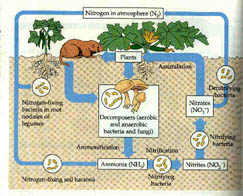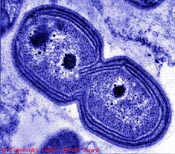




Nitrogen is an important element in organic processes, because it is essential for the creation of proteins and nucleic acid.Nitrogen constitutes around 79% of the atmosphere and is largely inert. A few microorganisms are capable of absorbing nitrogen, in a process called nitrogen fixation. Some prokaryotes (bacteria, cyanobacteria and archaea) can fix atmospheric nitrogen into ammonia (NH3). Ammonia can be produced by two different groups of fixers. One is associated with plant roots, while the other lives free in the soil.

The Nitrogen Cycle
Nitrogen fixers associated with plants are more efficient than free-fixers, because they are oxygen-protected inside the root cells. They live by receiving nutrients absorbed by the host plants. This symbiotic relationship enables the plant to receive a supply of nitrogen in the form of ammonia and this can be directly incorporated to make proteins.
Nitrosomonas bacteria transform the ammonia into nitrites. The nitrite is then transformed into nitrate by Nitrobacter bacteria. They use the energy liberated in the nitrification process to synthesize organic substances. Nitrate can then be absorbed by plants that use the nitrogen in proteins and nucleic acid formation.
Nitrogen is transferred from one organism to another via the food chain. Animals only have access to nitrogen by eating plants, or animals that have previously fed on plants, directly or indirectly.

Cross-section through nitrifying bacteria © Mary Ann
Bruns, Center for Microbial Ecology, Michigan State University
Nitrogen returns to the environment by excretion and decomposition. In both cases, the nitrogen compounds are transformed into ammonia. This in turn can return to the nitrogen cycle by the action of nitrifying bacteria. Alternatively it can be transformed into gaseous nitrogen by denitrifying bacteria, where it is returned to the atmosphere and thus completes the cycle.
In the rainforest the bacteria associated with the nitrogen cycle are both efficient and numerous. However, they are dependent upon abundant food supplies and transportation processes. They occupy only a narrow zone of soil and humus, so when deforestation takes place they are lost very quickly.
Go
to
Home
| Space Station
| Mars | Rainforest
© 1999 Satellite Events Enterprises Inc.